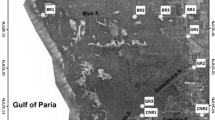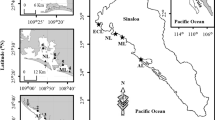Abstract
Bioaccessibility describes the fraction of contaminants released from the food matrix into the digestive tracts of humans, which is beneficial for improving the health risk assessment of contaminants. In this study, the bioaccessibilities of cadmium (Cd), copper (Cu), and zinc (Zn) in two severely contaminated green oyster (Crassostrea angulate) and blue oyster (Crassostrea hongkongensis) populations were investigated. A human health risk assessment of these metals was then performed based on bioaccessibility measurements. Among the three metals, the bioaccessibility was the highest for Cu (42–95 %), and Cd and Zn had comparable bioaccessibility (13–58 %). There was no major difference in the bioaccessibility between green and blue oysters. A significant correlation between the tissue Cu and Zn concentrations was found in these highly contaminated oysters. A health risk assessment showed that all three metals in both oyster species seriously exceeded the levels recommended by the United States Environmental Protection Agency. Thus, oysters from these locations, and the metals contained therein, presented quite high risks for human consumption, which should be a great cause of concern. A significant relationship was only found between metal bioaccessibility and its tissue concentration instead of between metal bioaccessibility and subcellular distribution. In addition, a significant relationship was only observed between metal health risks and its tissue concentration. The influence of metal bioaccessibilities on the health risks was limited. This may suggest that in the case of the colored oysters examined in this study, metal concentration instead of metal subcellular distribution could be the driving factor of the metal bioaccessibility, and metal concentration, instead of metal bioaccessibility, could be the driving factor of the metal health risks.







Similar content being viewed by others
References
Almela C, Laparra JM, Velez D, Barbera R, Farre R, Montoro R (2005) Arsenosugars in raw and cooked edible seaweed: characterization and bioaccessibility. J Agric Food Chem 53:7344–7351
Amiard JC, Amiard-Triquet C, Berthet B, Metayer C (1987) Comparative study of the patterns of bioaccumulation of essential (Cu, Zn) and non-essential (Cd, Pb) trace metals in various estuarine and coastal organisms. J Exp Mar Biol Ecol 106:73–89
Amiard JC, Amiard-Triquet C, Charbonnier L, Mesnil A, Rainbow PS, Wang WX (2008) Bioaccessibility of essential and non-essential metals in commercial shellfish from Western Europe and Asia. Food Chem Toxicol 46:2010–2022
Bragigand V, Berthet B, Amiard JC, Rainbow PS (2004) Estimates of trace metal bioavailability to humans ingesting contaminated oysters. Food Chem Toxicol 42:1893–1902
Brandon EFA, Oomen AG, Rompelberg CJM, Versantvoort CHM, van Engelen JGM, Sips AJAM (2006) Consumer product in vitro digestion model: bioaccessibility of contaminants and its application in risk assessment. Regul Toxicol Phamacol 44:161–171
Cabanero AI, Madrid Y, Camara C (2004) Selenium and mercury bioaccessibility in fish samples: an in vitro digestion method. Anal Chim Acta 526:51–61
Campbell PGC, Hare L (2009) Metallothioneins and related chelators: metal detoxification in freshwater animals. Roles of metallothioneins. Metal Ions Life Sci 5:239–277
Cheung MS, Wang WX (2005) Influence of subcellular metal compartmentalization in different prey on the transfer of metals to a predatory gastropod. Mar Ecol Prog Ser 286:155–166
Dang F, Wang WX (2010) Subcellular controls of mercury trophic transfer to a marine fish. Aquat Toxicol 99:500–506
FAO (2010) Food security data and definitions: Food consumption. Food consumption growth versus population growth. Food groups. Food and Agricultural Organization of the United Nations. http://www.fao.org/economic/ess/ess-fs/ess-fadata/en/#food_consumption
Gu DF, He J, Duan XF, Reynolds K, Wu XG, Chen J et al (2006) Body weight and mortality among men and women in China. J Am Med Assoc 295:776–783
Han B, Hung T (1990) Green oysters caused by copper pollution on the Taiwan coast. Environ Pollut 65:347–362
He M, Wang WX (2011) Factors affecting the bioaccessibility of methylmercury in several marine fish species. J Agric Food Chem 59:7155–7162
He M, Wang WX (2013) Bioaccessibility of twelve trace elements in marine molluscs: dependent on subcellular distribution. Food Chem Toxicol 55:627–636
He M, Ke CH, Wang WX (2010) Effects of cooking and subcellular distribution on the bioaccessibility of trace elements in two marine fish species. J Agric Food Chem 58:3517–3523
Hemalatha S, Platel K, Srinivasan K (2007) Influence of heat processing on the bioaccessibility of zinc and iron from cereals and pulses consumed in India. J Trace Elem Med Biol 21:1–7
Houlbreque F, Herve-Fernandez P, Teyssie JL, Oberhaensli F, Boisson F, Jeffree R (2011) Cooking makes cadmium contained in Chilean mussels less bioaccessible to humans. Food Chem 126:917–921
Intawongse M, Dean JR (2006) In-vitro testing for assessing oral bioaccessibility of trace metals in soil and food samples. Trends Anal Chem 25:876–886
Intawongse M, Dean JR (2008) Use of the physiologically-based extraction test to assess the oral bioaccessibility of metals in vegetable plants grown in contaminated soil. Environ Pollut 152:60–72
Koch I, McPherson K, Smith P, Easton L, Doe KG, Reimer KJ (2007) Arsenic bioaccessibility and speciation in clams and seaweed from a contaminated marine environment. Mar Pollut Bull 54:586–594
Kulkarni SD, Acharya R, Rajurkar NS, Reddy AVR (2007) Evaluation of bioaccessibility of some essential elements from wheatgrass (Triticum aestivum L.) by in vitro digestion method. Food Chem 103:681–688
Laird BD, Shade C, Gantner N, Chan HM, Siciliano SD (2009) Bioaccessibility of mercury from traditional northern country foods measured using an in vitro gastrointestinal model is independent of mercury concentration. Sci Total Environ 407:6003–6008
Laparra JM, Velez D, Montoro R, Barbera R, Farre R (2003) Estimation of arsenic bioaccessibility in edible seaweed by an in vitro digestion method. J Agric Food Chem 51:6080–6085
Laparra JM, Glahn RP, Miller DD (2008) Bioaccessibility of phenols in common beans (Phaseolus vulgaris L.) and iron (Fe) availability to Caco-2 cells. J Agric Food Chem 56:10999–11005
Lin S, Hsieh IJ (1999) Occurrences of green oyster and heavy metals contaminant levels in the Sien-San area, TaiWan. Mar Pollut Bull 38:960–965
Liu RQ, Zhao DY (2007) The leachability, bioaccessibility, and speciation of Cu in the sediment of channel catfish ponds. Environ Pollut 147:593–603
Metian M, Charbonnier L, Oberhaensli F, Bustamante P, Jeffree R, Amiard JC et al (2009) Assessment of metal, metalloid, and radionuclide bioaccessibility from mussels to human consumers using centrifugation and simulated digestion methods coupled with radiotracer techniques. Ecotoxicol Environ Saf 72:1499–1502
Ng TYT, Wang WX (2007) Interactions of silver, cadmium, and copper accumulation in green mussels (Perna viridis). Environ Toxicol Chem 26:1764–1769
Oomen AG, Hack A, Minekus M, Zeijdner E, Cornelis C, Schoeters G et al (2002) Comparison of five in vitro digestion models to study the bioaccessibility of soil contaminants. Environ Sci Technol 36:3326–3334
Oomen AG, Rompelberg CJM, Bruil MA, Dobbe CJG, Pereboom DPKH, Sips AJAM (2003) Development of an in vitro digestion model for estimating the bioaccessibility of soil contaminants. Arch Environ Contam Toxicol 44:281–288
Pan K, Wang WX (2012) Reconstructing the biokinetic processes of oysters to counteract the metal challenges: resistance development. Environ Sci Techonol 46:10765–10771
Roosenburg WH (1969) Greening and copper accumulation in the American oyster, Crassostrea virginica, in the vicinity of a steam electric generating station. Chesapeake Sci 10:241–252
Standardization Administration of the People’s Republic of China (2001) Safety qualification for agricultural product—Safety requirements for non-environmental pollution aquatic products. GB18406.4-2001, Beijing, China
Standardization Administration of the People’s Republic of China (2005) Maximum levels of contaminants in foods. GB2762-2005, Beijing, China
Tan QG, Wang WX (2008) The influences of ambient and body calcium on cadmium and zinc accumulation in Daphnia magna. Environ Toxicol Chem 27:1605–1613
Tepe Y, Türkmen M, Türkmen A (2008) Assessment of heavy metals in two commercial fish species of four Turkish seas. Environ Monit Assess 146:277–284
United States Environmental Protection Agency (USEPA) (2005). Risk-based Concentration Table. April 2005. USEPA. Region 3, Philadelphia, PA. http://www.epa.gov/reg3hwmd/risk/human/index.htm
Versantvoort CHM, Oomen AG, Van de Kamp E, Rompelberg CJM, Sips AJAM (2005) Applicability of an in vitro digestion model in assessing the bioaccessibility of mycotoxins from food. Food Chem Toxicol 43:31–40
Wallace WG, Luoma SN (2003) Subcellular compartmentalization of Cd and Zn in two bivalves.II. Significance of trophically available metal (TAM). Mar Ecol Prog Ser 257:125–137
Wallace WG, Lopez GR, Levinton JS (1998) Cadmium resistance in an oligochaete and its effect on cadmium trophic transfer to an omnivorous shrimp. Mar Ecol Prog Ser 172:225–237
Wallace WG, Lee BG, Luoma SN (2003) Subcellular compartmentalization of Cd and Zn in two bivalves.I. Significance of metal-sensitive fractions (MSF) and biologically detoxified metal (BDM). Mar Ecol Prog Ser 249:183–197
Wang WX, Yang YB, Guo XY, He M, Guo F, Ke CH (2011) Copper and Zinc contamination in oysters: subcellular distribution and detoxification. Environ Toxicol Chem 30:1767–1774
Zhang L, Wang WX (2006) Significance of subcellular metal distribution in prey in influencing the trophic transfer of metals in a marine fish. Limnol Oceanogr 51:2008–2017
Acknowledgments
We thank the anonymous reviewers for their helpful comments on this work. This study was supported by a project from the National Natural Science Foundation of China (Grant No. 21207020) and a program of the Hubei Cooperative Innovation Center of Unconventional Oil and Gas at Yangtze University.
Author information
Authors and Affiliations
Corresponding author
Ethics declarations
Conflicts of Interest
The authors declare that they have no conflicts of interest. The submitted work has not received any financial support from any third party, and there is no financial relationship with any entities. All of the financial organizations associated with this work have been disclosed. There is no patent, whether planned, pending or issued, broadly relevant to the submitted work.
Electronic Supplementary Material
Below is the link to the electronic supplementary material.
Rights and permissions
About this article
Cite this article
He, M., Ke, CH., Tian, L. et al. Bioaccessibility and Health Risk Assessment of Cu, Cd, and Zn in “Colored” Oysters. Arch Environ Contam Toxicol 70, 595–606 (2016). https://doi.org/10.1007/s00244-015-0194-z
Received:
Accepted:
Published:
Issue Date:
DOI: https://doi.org/10.1007/s00244-015-0194-z




